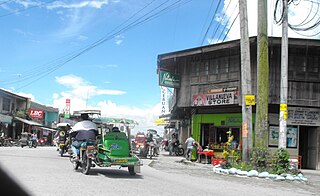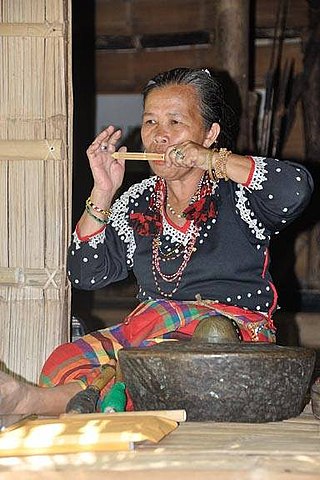Sebu may refer to:
- Cebu, a city in the Philippines
- Sebu Simonian, Syrian musician
- Lake Sebu, a lake in the Philippines
Sebu may refer to:

South Cotabato, officially the Province of South Cotabato, and since 2019, South Cotabato was renamed in the Province as Cotabato del Sur , is a province in the Philippines located in the Soccsksargen region in Mindanao. Its capital is Koronadal, and it borders Sultan Kudarat to the north and west, Sarangani to the south and northeast, and Davao del Sur to the far northeast. To the southeast lies Sarangani Bay.

Sarangani, officially the Province of Sarangani, is a province in the Philippines located in the Soccsksargen region. Its capital is Alabel while Glan is the most populous municipality in the province. With a 230-kilometer (140 mi) coastline along the Sarangani Bay and Celebes Sea, the province is at the southernmost tip of Mindanao island, and borders South Cotabato and Davao del Sur to the north, Davao Occidental to the east, and the Celebes Sea to the south.
Moron or Morón may refer to:

The Tboli people are an Austronesian indigenous peoples of South Cotabato in southern Mindanao in the Philippines.

The Allah Valley is a large valley of the Allah River in the provinces of South Cotabato and Sultan Kudarat on the island of Mindanao, Philippines. It is formed by the Roxas-Matulas Range in the north and the Daguma Mountain Range in the south.

Lake Sebu, officially the Municipality of Lake Sebu, is a 1st class municipality in the province of South Cotabato, Philippines. According to the 2020 census, it has a population of 81,221 people.

Maguindanaon, or Magindanawn is an Austronesian language spoken by Maguindanaon people who form majority of the population of eponymous provinces of Maguindanao del Norte and Maguindanao del Sur in the Philippines. It is also spoken by sizable minorities in different parts of Mindanao such as the cities of Zamboanga, Davao, General Santos, and Cagayan de Oro, and the provinces of North Cotabato, Sultan Kudarat, South Cotabato, Sarangani, Zamboanga del Sur, Zamboanga Sibugay, Davao del Sur, Davao Occidental as well as Metro Manila, Bulacan, Cavite and Laguna. As of 2020, the language is ranked to be the ninth leading language spoken at home in the Philippines with only 365,032 households still speaking the language.

Lake Sebu is a natural lake located in the municipality of Lake Sebu, South Cotabato within the Alah Valley region. The Philippine government has recognized it as one of the country's most important watersheds. Lake Sebu is one of the many bodies of water supplying important irrigation to the provinces of Sultan Kudarat and South Cotabato.

Surallah, officially the Municipality of Surallah, is a 1st class municipality in the province of South Cotabato, Philippines. According to the 2020 census, it has a population of 89,340 people.
The legislative districts of South Cotabato are the representations of the province of South Cotabato and the urbanized city of General Santos in the various national legislatures of the Philippines. The province is currently represented in the lower house of the Congress of the Philippines through its first and second congressional districts.

The Blaan people, are one of the indigenous peoples of Southern Mindanao in the Philippines. Their name could have derived from "bla" meaning "opponent" and the suffix "an" meaning "people". According to a 2021 genetic study, the Blaan people also have Papuan admixture.

The 2002 Mindanao earthquake struck the Philippines at 05:16 Philippine Standard Time on March 6. The world's sixth most powerful earthquake of the year, it registered a magnitude of 7.5 and was a megathrust earthquake. It originated near the Cotabato Trench, a zone of deformation situated between the Philippine Sea Plate and the Sunda Plate, and occurred very near to the Philippines' strongest earthquake for the 20th century, the 1918 Celebes Sea earthquake.

Tnalak, is a weaving tradition using resist-dyed threads of the Tboli people of South Cotabato, Philippines. T'nalak cloth is woven exclusively by women who have received the designs for the weave in their dreams, which they believe are a gift from Fu Dalu, the T'boli Goddess of abacá.
The Ala River flows through the Allah Valley on the island of Mindanao in the Philippines. It is located in the provinces of South Cotabato, Sultan Kudarat and Maguindanao. The name of the river could have come from the word of Allah itself, which is the meaning of God in Arabic.
Intangible cultural heritage (ICH) includes traditions and living expressions that are passed down from generation to generation within a particular community.

Cotabato, also known as the Province of Cotabato, was a historical province of the Philippines established in 1914 that existed until its dissolution in 1973. The province's capital from 1920 to 1967 was Cotabato City while Pagalungan became its capital from 1967 to 1973.
Lang Dulay was a Filipino traditional weaver who was a recipient of the National Living Treasures Award.

Owong, also spelled owung, are traditional small dugout canoes of the T'boli people in the Philippines. It is traditionally made from the hollowed out trunks of lawaan (Shorea spp.). It is propelled by paddling and can carry around three people. It is used by the T'boli people for fishing and transport in Lake Sebu, Lake Lahit, and Lake S'loton in their ancestral territory in southwestern Mindanao.

South Cotabato's 2nd congressional district is one of the two congressional districts of the Philippines in the province of South Cotabato. It has been represented in the House of Representatives since 1987. The district covers the provincial capital city, Koronadal, and seven adjacent municipalities, namely Banga, Lake Sebu, Norala, Santo Niño, Surallah, Tantangan and T'boli. It is currently represented in the 19th Congress by Peter Miguel of the Lakas–CMD.
South Cotabato's 3rd congressional district is a congressional district that previously encompassed the Sarangani Bay region, a former territory of South Cotabato. It was represented in the House of Representatives from its creation under the ordinance annex of the 1987 Constitution of the Philippines that divided the province into three congressional districts, until 1995. The district was dissolved following the ratification of Sarangani's organic law of March 1992 which elected its own provincial at-large representative beginning in May 1995.